News from the bottom: IT giants have begun actively building their own submarine backbone networks
We have long been accustomed to the fact that large IT companies are engaged not only in the release of products and services, but also actively participate in the development of Internet infrastructure. Google’s DNS, Amazon’s cloud storage and hosting, Facebook data centers around the world - fifteen years ago, it seemed too ambitious, and now it’s the norm that everyone is used to.
And now, the four largest IT companies represented by Amazon, Google, Microsoft and Facebook have reached the point that they have begun to invest not only in data centers and servers directly, but also in the main cables themselves - that is, they have entered the territory that has traditionally been area of responsibility for completely different structures. Moreover, judging by the conclusions on the APNIC blog, the aforementioned quartet of technological giants swung not just at terrestrial networks, but at backbone transcontinental communication lines, i.e. all of us are familiar with submarine cables.
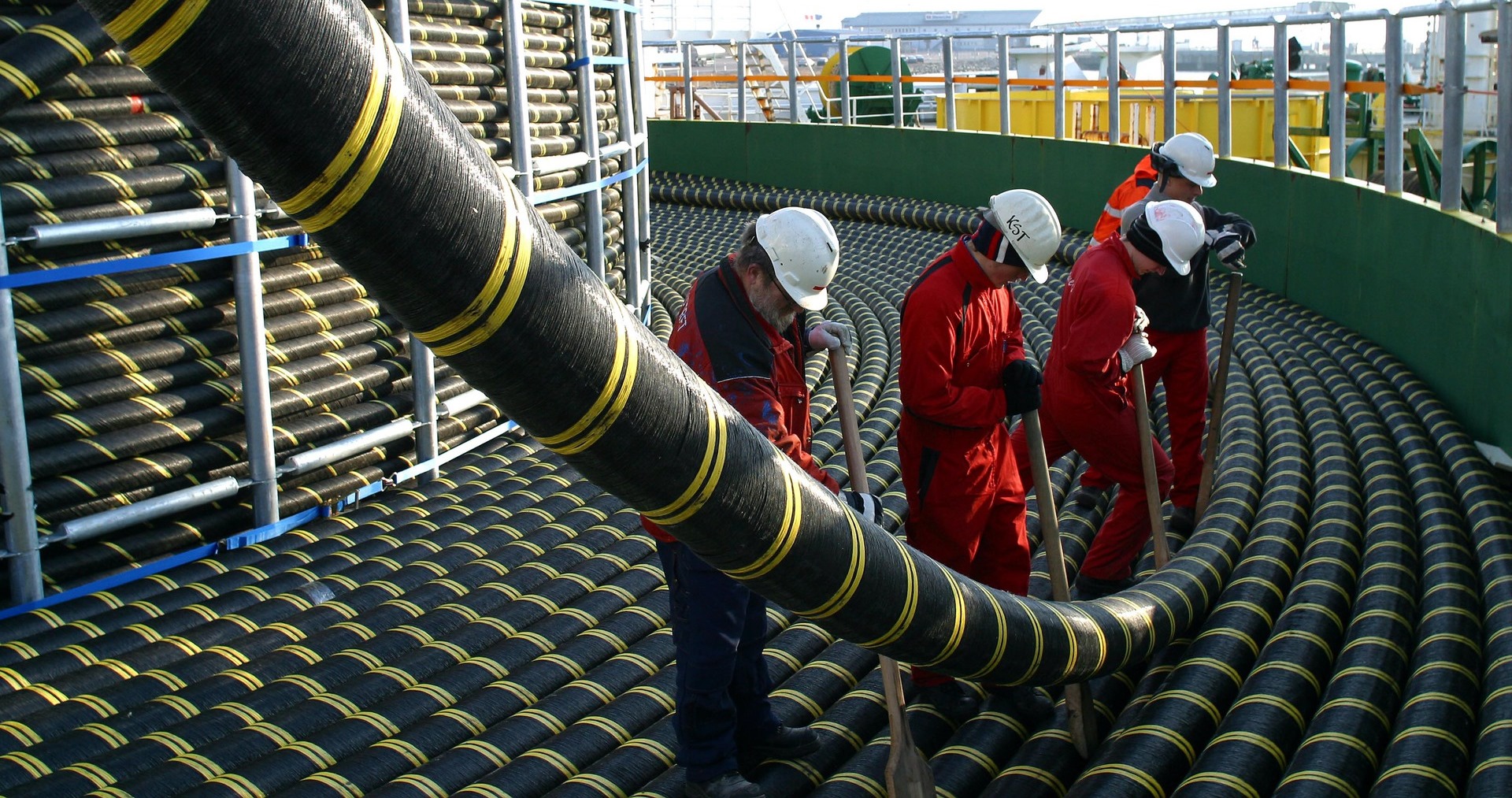
The most surprising thing is that there is no urgent need for new networks now, but companies are actively increasing throughput "in reserve". Unfortunately, it’s almost impossible to find intelligible statistics about global traffic generation thanks to the numerous marketers who operate with dimensions like “65 million posts on Instagram daily” or “N search queries on Google” instead of petabytes that are transparent and understandable to technical experts. One can cautiously assume that daily traffic is ≈2.5 * 10 ^ 18 bytes or about 2500 petabytes of data.
One of the reasons why modern backbone networks should expand is the growing popularity of the Netflix streaming service and the parallel growth of the mobile segment. With the general trend to increase the visual component of video content in terms of resolution and bit rate, as well as an increase in the consumption of mobile traffic by an individual user (against the background of a general slowdown in sales of mobile devices around the world), backbone networks can still not be overloaded.
Let's look at the underwater internet map from Google :

It is visually difficult to determine how many new tracks were laid, and the service itself is updated almost daily, without providing an intelligible history of changes or any other consolidated statistics. Therefore, we turn to older sources. According to the information already on this map (50 Mb !!!) , the bandwidth of existing intercontinental backbone networks in 2014 was about 58 Tbit / s, of which only 24 Tbit / s was actually used: For those who are angrily flexing their fingers and preparing to write: "I do not believe! Too little! ”, Recall that we are talking about intercontinental traffic
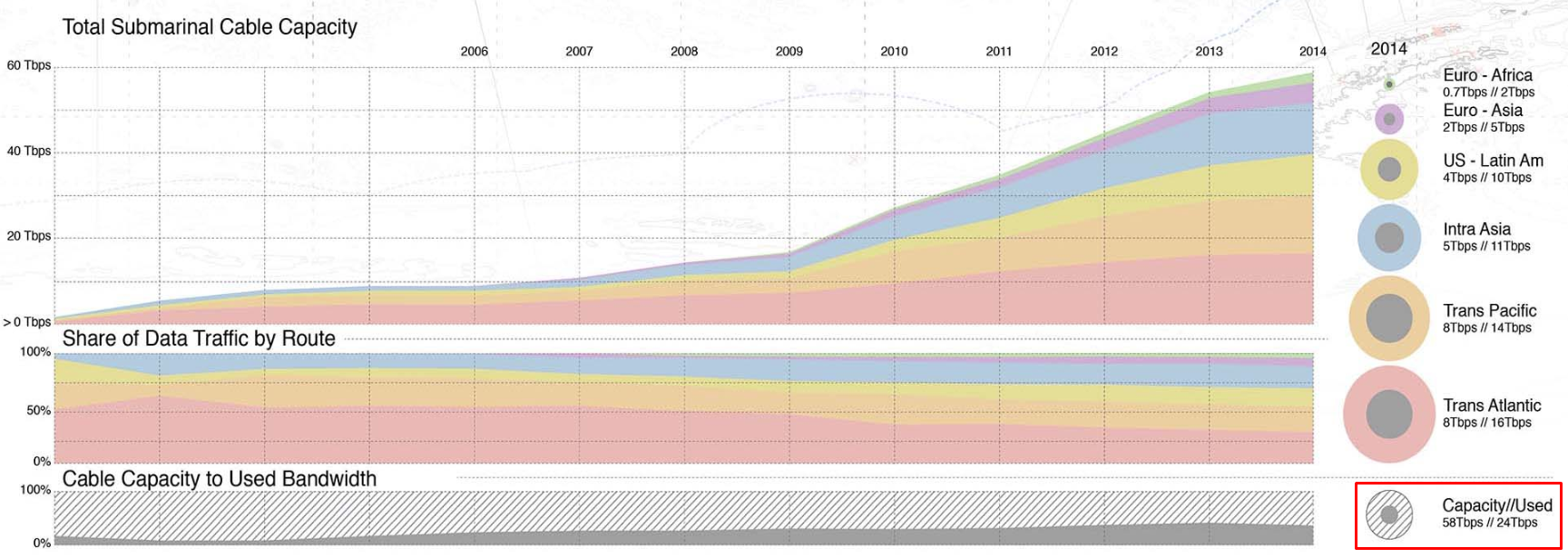
, that is, it is a priori much lower than inside a particular region, since we have not yet restrained quantum teleportation and cannot hide or hide from a ping of 300-400 ms.
In 2015, a forecast was made that from 2016 to 2020, a total of 400,000 more trunk cables will extend along the ocean floor, which will significantly increase the throughput of the global network.
However, if we look at the statistics shown on the map above, specifically about 26 Tbit / s load with a total channel of 58 Tbit / s, natural questions arise: why and why?
Firstly, IT giants began laying their own backbone networks in order to increase the connectivity of elements of the internal infrastructure of companies on different continents. It is because of the previously mentioned ping in almost half a second between two opposite points of the globe, IT companies have to refine their efforts to ensure the stability of their "economy". These issues are most acute for Google and Amazon; the first began laying their own networks back in 2014, when they decided to “route” the cable between the eastern coast of the USA and Japan to connect their data centers, which was then written about in Habré . Only to connect two separate data centers, the search giant was ready to spend $ 300 million and stretch about 10 thousand kilometers of cable along the bottom of the Pacific Ocean.
If someone did not know or forgot, then underwater cable laying is a quest of increased complexity, from immersion of reinforced structures with a diameter of up to half a meter in coastal areas and ending with endless landscape exploration for laying the main part of the highway at a depth of several kilometers. When it comes to the Pacific Ocean, the complexity only increases in proportion to the depth and number of mountain ranges on the ocean floor. Such events require specialized vessels, a specially trained team of specialists and, in fact, several years of hard work, if we consider the installation from the design and exploration stage to, in fact, the final commissioning of the network section. Plus, here you can add the coordination of work and the construction of relay stations on the shore with local governments, work with environmentalists,
Perhaps, in recent years, new vessels were put into operation, but five years ago, the main cable layers of the same Huawei (yes, the Chinese company is one of the leaders in this market), there was a solid turn for many months to come. Against the background of all this information, the activity of technological giants in this segment looks more and more interesting.
The official position of all major IT companies: ensuring the connectivity (independence from common networks) of their data centers. And here is what the underwater maps of different market players look like according to telegeography.com :

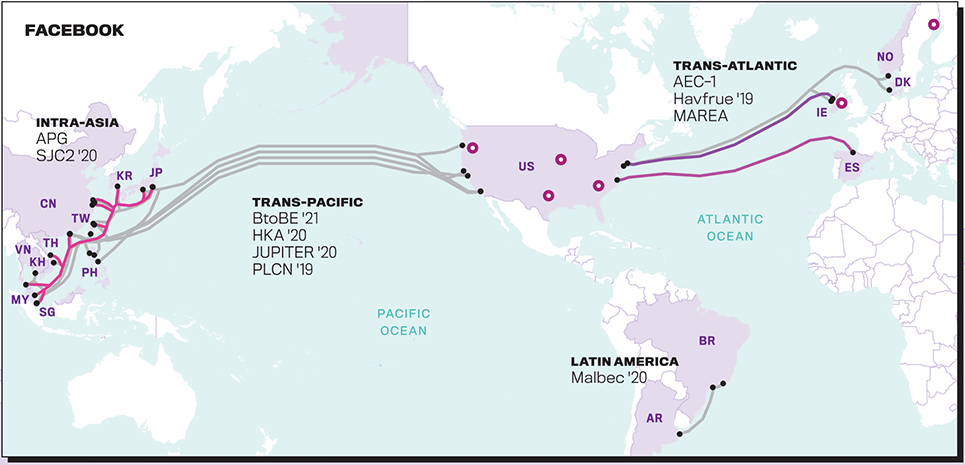
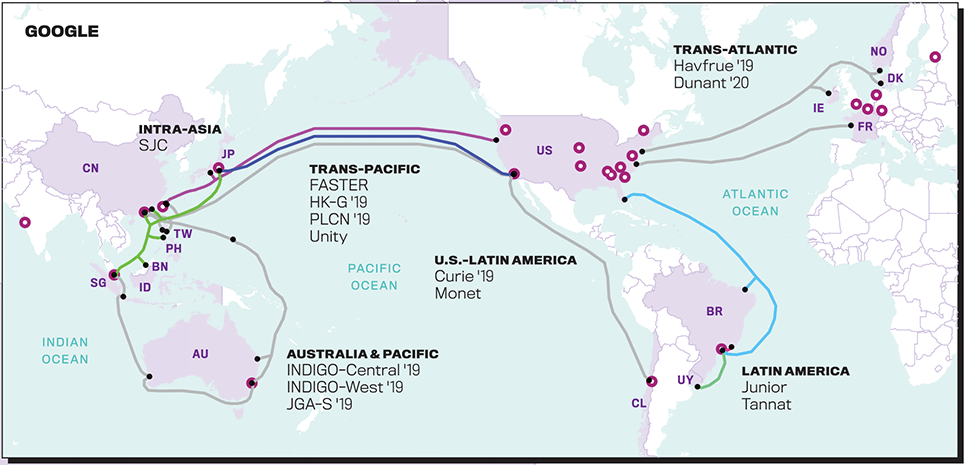
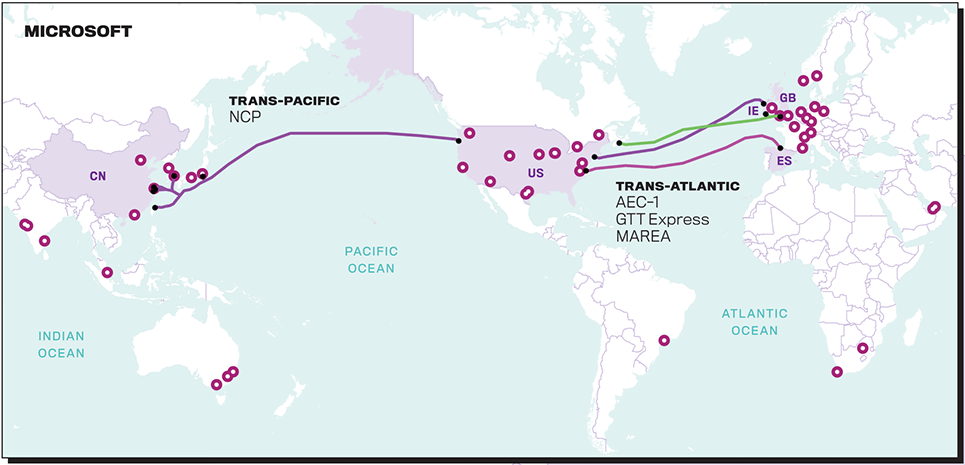
As you can see on the maps, the most impressive appetites are not Google or Amazon, but Facebook, which has long ceased to be "just a social network." There is also a clear interest of all major players in the Asia-Pacific region, and only Microsoft is still reaching for the Old World. If it is trite to count the marked highways, then you can find out that only these four companies are co-owners or full owners of 25 already built or finally planned for laying trunk lines, most of which stretch towards Japan, China and all of Southeast Asia. At the same time, we provide only statistics on the four IT giants mentioned earlier, and besides them, Alcatel, NEC, Huawei and Subcom are actively building their own networks.
In general, the number of private or with the participation of private capital transcontinental highways has grown significantly since 2014 - from the moment when Google announced the previously mentioned connection of its data center in the USA with a data center in Japan:

Actually, the motivation is “we want to connect our date centers ”is not enough: companies hardly need binding for the sake of binding. Rather, they want to isolate the transmitted information and secure their own internal infrastructure.
If you take a foil hat out of a desk drawer, straighten it and pull it tight, you can formulate a very, very cautious hypothesis of the following plan: now we are observing the emergence of the Internet of a new formation, in fact, a global corporate network. If you recall that Amazon, Google, Facebook and Microsoft account for at least half of the global traffic consumption (Amazon hosting, Google search and services, social networks Facebook and Instagram, and desktops running Windows from Microsoft), then you need to get the second hat. Because in theory, in a very vague theory, if projects of the Google Fiber type (this is one in which Google has tried itself as a provider for the population) appear in the regions, now we are witnessing the emergence of a second Internet, which so far coexists with the already built .
And now, the four largest IT companies represented by Amazon, Google, Microsoft and Facebook have reached the point that they have begun to invest not only in data centers and servers directly, but also in the main cables themselves - that is, they have entered the territory that has traditionally been area of responsibility for completely different structures. Moreover, judging by the conclusions on the APNIC blog, the aforementioned quartet of technological giants swung not just at terrestrial networks, but at backbone transcontinental communication lines, i.e. all of us are familiar with submarine cables.

The most surprising thing is that there is no urgent need for new networks now, but companies are actively increasing throughput "in reserve". Unfortunately, it’s almost impossible to find intelligible statistics about global traffic generation thanks to the numerous marketers who operate with dimensions like “65 million posts on Instagram daily” or “N search queries on Google” instead of petabytes that are transparent and understandable to technical experts. One can cautiously assume that daily traffic is ≈2.5 * 10 ^ 18 bytes or about 2500 petabytes of data.
One of the reasons why modern backbone networks should expand is the growing popularity of the Netflix streaming service and the parallel growth of the mobile segment. With the general trend to increase the visual component of video content in terms of resolution and bit rate, as well as an increase in the consumption of mobile traffic by an individual user (against the background of a general slowdown in sales of mobile devices around the world), backbone networks can still not be overloaded.
Let's look at the underwater internet map from Google :

It is visually difficult to determine how many new tracks were laid, and the service itself is updated almost daily, without providing an intelligible history of changes or any other consolidated statistics. Therefore, we turn to older sources. According to the information already on this map (50 Mb !!!) , the bandwidth of existing intercontinental backbone networks in 2014 was about 58 Tbit / s, of which only 24 Tbit / s was actually used: For those who are angrily flexing their fingers and preparing to write: "I do not believe! Too little! ”, Recall that we are talking about intercontinental traffic

, that is, it is a priori much lower than inside a particular region, since we have not yet restrained quantum teleportation and cannot hide or hide from a ping of 300-400 ms.
In 2015, a forecast was made that from 2016 to 2020, a total of 400,000 more trunk cables will extend along the ocean floor, which will significantly increase the throughput of the global network.
However, if we look at the statistics shown on the map above, specifically about 26 Tbit / s load with a total channel of 58 Tbit / s, natural questions arise: why and why?
Firstly, IT giants began laying their own backbone networks in order to increase the connectivity of elements of the internal infrastructure of companies on different continents. It is because of the previously mentioned ping in almost half a second between two opposite points of the globe, IT companies have to refine their efforts to ensure the stability of their "economy". These issues are most acute for Google and Amazon; the first began laying their own networks back in 2014, when they decided to “route” the cable between the eastern coast of the USA and Japan to connect their data centers, which was then written about in Habré . Only to connect two separate data centers, the search giant was ready to spend $ 300 million and stretch about 10 thousand kilometers of cable along the bottom of the Pacific Ocean.
If someone did not know or forgot, then underwater cable laying is a quest of increased complexity, from immersion of reinforced structures with a diameter of up to half a meter in coastal areas and ending with endless landscape exploration for laying the main part of the highway at a depth of several kilometers. When it comes to the Pacific Ocean, the complexity only increases in proportion to the depth and number of mountain ranges on the ocean floor. Such events require specialized vessels, a specially trained team of specialists and, in fact, several years of hard work, if we consider the installation from the design and exploration stage to, in fact, the final commissioning of the network section. Plus, here you can add the coordination of work and the construction of relay stations on the shore with local governments, work with environmentalists,
Perhaps, in recent years, new vessels were put into operation, but five years ago, the main cable layers of the same Huawei (yes, the Chinese company is one of the leaders in this market), there was a solid turn for many months to come. Against the background of all this information, the activity of technological giants in this segment looks more and more interesting.
The official position of all major IT companies: ensuring the connectivity (independence from common networks) of their data centers. And here is what the underwater maps of different market players look like according to telegeography.com :




As you can see on the maps, the most impressive appetites are not Google or Amazon, but Facebook, which has long ceased to be "just a social network." There is also a clear interest of all major players in the Asia-Pacific region, and only Microsoft is still reaching for the Old World. If it is trite to count the marked highways, then you can find out that only these four companies are co-owners or full owners of 25 already built or finally planned for laying trunk lines, most of which stretch towards Japan, China and all of Southeast Asia. At the same time, we provide only statistics on the four IT giants mentioned earlier, and besides them, Alcatel, NEC, Huawei and Subcom are actively building their own networks.
In general, the number of private or with the participation of private capital transcontinental highways has grown significantly since 2014 - from the moment when Google announced the previously mentioned connection of its data center in the USA with a data center in Japan:

Actually, the motivation is “we want to connect our date centers ”is not enough: companies hardly need binding for the sake of binding. Rather, they want to isolate the transmitted information and secure their own internal infrastructure.
If you take a foil hat out of a desk drawer, straighten it and pull it tight, you can formulate a very, very cautious hypothesis of the following plan: now we are observing the emergence of the Internet of a new formation, in fact, a global corporate network. If you recall that Amazon, Google, Facebook and Microsoft account for at least half of the global traffic consumption (Amazon hosting, Google search and services, social networks Facebook and Instagram, and desktops running Windows from Microsoft), then you need to get the second hat. Because in theory, in a very vague theory, if projects of the Google Fiber type (this is one in which Google has tried itself as a provider for the population) appear in the regions, now we are witnessing the emergence of a second Internet, which so far coexists with the already built .
Only registered users can participate in the survey. Please come in.
Do you think this actually looks like building a “parallel Internet” or are we just suspicious?
- 41.2% Yes, it seems. 180
- 29.5% No, they just need a stable connection between the data centers and there are no threats here. 129
- 26.8% you definitely need a less tight cap made of foil, this one presses on the brains. 117
- 2.2% Own option in the comments. 10
